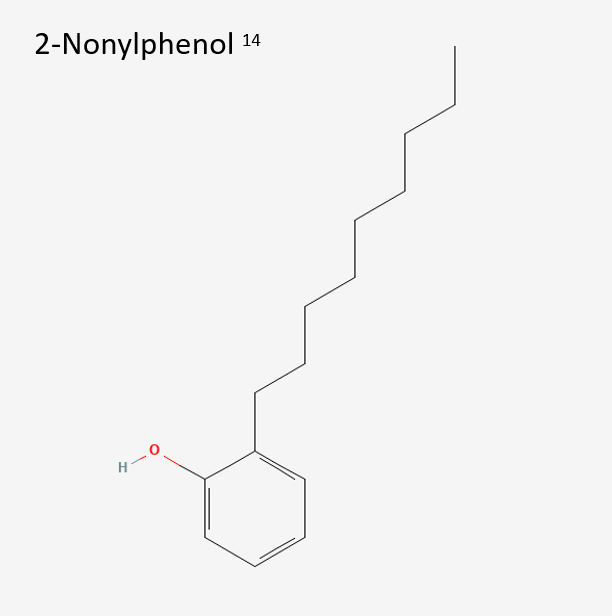SedimentAlkylphenols (µg TEQ/kg dry weight)
|
MusselsAlkylphenols (µg/kg wet weight)
|
|
|---|---|---|
|
|
North |
|
| South |
What are they?
Alkylphenols (APs) are synthetic compounds that are used to make alkylphenol ethoxylates (APEs), widely used as surfactants in detergents, degreasers, emulsifiers, wetting agents, and dispersing agents. APEs are used in numerous industries, including textiles, pulp and paper, metal processing, oil and gas, power, food and beverage, plastics, construction, paints, and pesticides.1 Nonylphenol (NP) and nonylphenol ethoxylates (NPEs) are the most widely used AP/APEs.1

How do they get into the ocean?
Alkylphenols enter the marine environment through wastewater discharges, combined sewer overflows, and surface runoff, and have been detected previously in effluent and runoff in south coastal British Columbia.1 Although information about APs in the marine environment is limited, studies suggest that NP and NPEs are the dominant alkylphenol compounds in marine sediments. These compounds are water-soluble but also bind to sediments, taking several months to degrade.2 Although the dominant marine NP compounds are not considered highly bioaccumulative, researchers have observed substantial bioaccumulation of NPs in fish.3
Nonylphenol is used to produce nonylphenol ethoxylates, but its presence in the marine environment is largely due to the breakdown of NPEs once they reach wastewater treatment systems.4
Are they a problem?
NP and NPEs are defined as toxic under the Canadian Environmental Protection Act 5 and are extremely toxic to aquatic life. NPEs are less toxic and persistent in the environment than NP but are also toxic to aquatic organisms. These compounds are endocrine disruptors: they can mimic estrogen and, in turn, disrupt regular hormone processes.4,6 NP has been detected in breast milk, blood, and urine in humans, and is associated with reproductive and developmental effects in rodents.7
FACT: Nonylphenol was added to an insecticide formulation sprayed over forests in the Canadian Atlantic provinces from 1976 to 1981. This spraying was later found responsible for declines in local Atlantic salmon populations, where salmon smolts were exposed to nonylphenol in their freshwater habitat.2
What is being done?
Due to their known toxicity in the aquatic environment, Canada implemented changes to the use of NP and NPEs at facilities in 2004, resulting in reductions in releases from soaps and cleaning products, textile mills, and pulp and paper mills. As of 2014, Environment Canada requires all facilities releasing more than 1,000 kg of these compounds to report their outputs.8,9
Due to a lack of data, few regulatory guidelines exist for alkylphenols; however, interim Canadian and British Columbia marine water and sediment quality guidelines have been developed for NP (Table 1). The marine water quality guideline is based on observed effects on growth in a marine shrimp species.10 The sediment quality guideline is based on the water quality guideline and is protective of benthic marine invertebrates.10,13 Alkylphenol guidelines are not currently available for the protection of organisms higher up in the food chain, such as marine mammals and birds.
Table 1. Federal and Provincial Interim Marine Water & Sediment Quality Guidelines for NP 10, 13 
What can you do?
As individuals and organizations, we can:
- Learn more about alkylphenols and other contaminants of concern using the resource links below
- Recycle and dispose of waste responsibly and according to local guidelines
- Avoid using products that contain alkylphenols and other contaminants of concern. The US EPA’s Safer Choice program identifies products that are safer for humans and the environment and can be used as a reference to check product ingredients.11,12
More Information?
1 Garrett C, Ross PS. 2010. Recovering resident killer whales: a guide to contaminant sources, mitigation, and regulations in British Columbia. Canadian Technical Report of Fisheries and Aquatic Sciences. 2894.
2 Fairchild W, Burridge L, Arsenault J, Bennie D, Cotter D, et al. 2010. Pollutants in river run-off from forest spraying and effects on Atlantic salmon. Presentation. In: Burt MDB, Wells PG (eds.). Threats to the health of the Bay of Fundy: potential problems posed by pollutants. BoFEP Technical Report No. 5.
3 Garrett C. 2004. Priority substances of interest in the Georgia Basin. Profiles and background information on current toxics issues. Technical Supporting Document of the Canadian Toxics Work Group. Puget Sound/Georgia Basin International Task Force. GBAP Publication No. EC/GB/04/79.
4 Soares A, Guieysse B, Jefferson B, Cartmell E, Lester JN. 2008. Nonylphenol in the environment: a critical review on occurrence, fate, toxicity and treatment in wastewaters. Environmental International. 34(7): 1033-1049.
5 Government of Canada. 2021. Canadian Environmental Protection Act, 1999. (S.C. 1999, c.33) Available at: Canadian Environmental Protection Act, 1999 (justice.gc.ca)
6 Environment Canada and Health Canada. 2001. Nonylphenol and its ethoxylates. Priority Substances List Assessment Report. Canadian Environmental Protection Act, 1999. Available at: http://www.hc-sc.gc.ca/ewh-semt/alt_formats/hecs-sesc/pdf/pubs/contaminants/psl2-lsp2/nonylphenol/nonylphenol-eng.pdf
7 United States Environmental Protection Agency (US EPA). 2017. Fact Sheet: Nonylphenols and Nonylphenol Ethoxylates. Available at: https://www.epa.gov/assessing-and-managing-chemicals-under-tsca/fact-sheet-nonylphenols-and-nonylphenol-ethoxylates
8 Environment and Climate Change Canada (ECCC). 2014a. Pollution Prevention Planning for Nonylphenol and its Ethoxylates in Products – Final Evaluation Report. Available at: https://www.ec.gc.ca/planp2-p2plan/54EE64B2-A75B-43E6-9673-0E47B89DBABD/NPEs_Final_Evaluation_Report.pdf
9 Environment and Climate Change Canada (ECCC). 2014b. Environment Canada’s Proposed Changes in Response to the National Pollutant Release Inventory Substance Review. Available at: https://www.canada.ca/en/environment-climate-change/services/national-pollutant-release-inventory/public-consultations/proposed-changes-response-substance-review.html
10 Canadian Council of Ministers of the Environment (CCME). 2002. Canadian water quality guidelines for the protection of aquatic life: Nonylphenol and its ethoxylates. In: Canadian environmental quality guidelines, 1999, Canadian Council of Ministers of the Environment, Winnipeg.
11 United States Environmental Protection Agency (US EPA). 2018. Safer Choice. Available at: https://www.epa.gov/saferchoice
12 United States Environmental Protection Agency (US EPA). 2012. DfE Alternatives Assessment for Nonylphenol Ethoxylates. Available at: https://www.epa.gov/sites/production/files/2014-06/documents/npe_final.pdf
13 British Columbia Ministry of Environment and Climate Change Strategy. 2021. Working Water Quality Guidelines: Aquatic Life, Wildlife & Agriculture. Water Quality Guideline Series, WQG-08. Prov. B.C., Victoria B.C. Available at: https://www2.gov.bc.ca/assets/gov/environment/air-land-water/water/waterquality/water-quality-guidelines/bc_env_working_water_quality_guidelines.pdf
14 PubChem Identifier: CID 67296 URL: 2-Nonylphenol | C15H24O – PubChem (nih.gov)